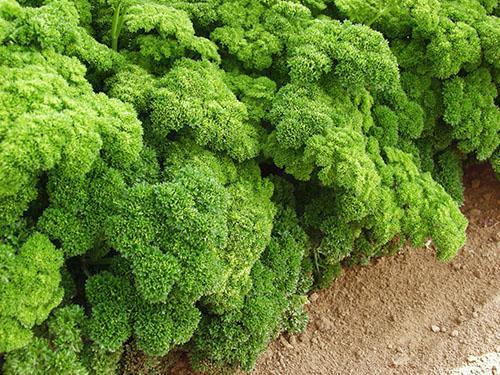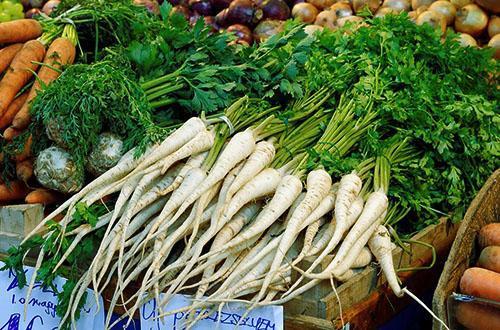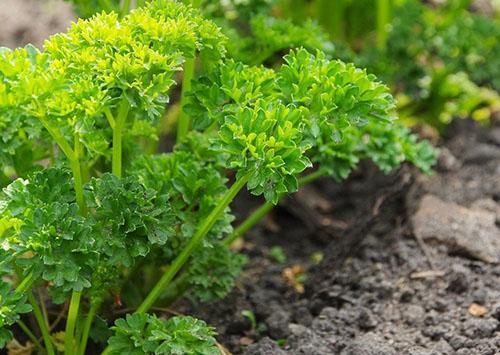Features of curly parsley and the way it is grown
 The history of a person's acquaintance with this culture begins in the Mediterranean countries and dates back to the era of the construction of the pyramids and ancient Hellas. Parsley earned the greatest recognition later, among the Romans, who introduced the other Europeans to the spicy herb. The Latin name for parsley, Petroselinum crispum, can most likely be translated as curly celery growing on rocks. This speaks of the similarity of cultures, but does not mean at all that already in Ancient Rome one could see the modern curly parsley, which is well known to gardeners all over the world.
The history of a person's acquaintance with this culture begins in the Mediterranean countries and dates back to the era of the construction of the pyramids and ancient Hellas. Parsley earned the greatest recognition later, among the Romans, who introduced the other Europeans to the spicy herb. The Latin name for parsley, Petroselinum crispum, can most likely be translated as curly celery growing on rocks. This speaks of the similarity of cultures, but does not mean at all that already in Ancient Rome one could see the modern curly parsley, which is well known to gardeners all over the world.

Curly parsley, with a characteristic leaf shape forming dense green caps above the beds, 15 to 40 cm high, is called Petroselinium Crispum var. Crispum.
In Russia, this variety appeared relatively recently, but in European countries, it is curly parsley that holds the palm among the listed related species.
What does curly parsley look like in the photo?
 Interestingly, the spread of curly herbs, for example, in the UK was not at all spectacular foliage or great taste. Even in the Middle Ages, planting plants with smooth foliage in beds was primarily feared because of their resemblance to the dangerous weed Aethusa Cynapium or dog parsley, which grew in abundance everywhere.
Interestingly, the spread of curly herbs, for example, in the UK was not at all spectacular foliage or great taste. Even in the Middle Ages, planting plants with smooth foliage in beds was primarily feared because of their resemblance to the dangerous weed Aethusa Cynapium or dog parsley, which grew in abundance everywhere.
 To understand what curly parsley looks like, you just need to glance at the photo showing both leafy species side by side. Such a plant cannot be confused with any cultivated or wild-growing relative. In ordinary garden parsley, the lower leaves, forming a basal rosette, have a triangular shape, blunt toothed ends and a smooth leaf plate of a dark green hue.
To understand what curly parsley looks like, you just need to glance at the photo showing both leafy species side by side. Such a plant cannot be confused with any cultivated or wild-growing relative. In ordinary garden parsley, the lower leaves, forming a basal rosette, have a triangular shape, blunt toothed ends and a smooth leaf plate of a dark green hue.
The greens of curly parsley are more rounded and cut. The denticles, which is clearly visible on young plants, are also rounded, and the leaf blade acquires a pronounced wavy shape as it grows. The rest of the features of related forms are almost identical. True, the disputes between culinary specialists and gardeners about the merits and weaknesses of curly and Italian parsley have not subsided for several centuries.
Those who prefer varieties with a wavy leaf shape talk about the greater decorativeness of the plant and its unpretentiousness:
- Curly parsley grows great outdoors and in greenhouses.
- Due to the corrugated leaf plate, the culture loses less moisture on hot dry days.
Therefore, when growing parsley at home, experienced gardeners are advised to choose exactly curly varieties:
- Garden parsley with smooth foliage can delight you with a bright aroma inherent in the foliage of the culture and its roots.
- The smell of parsley is retained after heat treatment, which is not typical for the curly variety.
 Curly foliage, with sufficient watering, has a softer and juicier consistency, is used fresh.Chopped foliage is good as a seasoning for many dishes, it is used to make juices, purees and sauces, and it is also dried.
Curly foliage, with sufficient watering, has a softer and juicier consistency, is used fresh.Chopped foliage is good as a seasoning for many dishes, it is used to make juices, purees and sauces, and it is also dried.
How to plant and grow curly parsley in the open field?
 Before planting parsley, a place for future beds is being prepared in the fall. In order for the harvest of spectacular greens in the next season to be friendly and abundant, it is better to set up a plantation for parsley in an area where cabbage, cucumbers or other types of pumpkins, potatoes, eggplants or tomatoes were previously grown. If you sow curly parsley in the place of related plants, you can involuntarily reduce the yield, since pathogens dangerous for the culture of diseases and larvae of pests can remain in the soil.
Before planting parsley, a place for future beds is being prepared in the fall. In order for the harvest of spectacular greens in the next season to be friendly and abundant, it is better to set up a plantation for parsley in an area where cabbage, cucumbers or other types of pumpkins, potatoes, eggplants or tomatoes were previously grown. If you sow curly parsley in the place of related plants, you can involuntarily reduce the yield, since pathogens dangerous for the culture of diseases and larvae of pests can remain in the soil.
How, growing parsley, prepare the beds for this culture?
- Before winter, the site is dug up, while adding humus, rotted compost or manure.
- And in the spring, when the snow melts, the soil is necessarily loosened, combining this process with the introduction of mineral additives.
Slowly emerging seeds of curly parsley are washed in warm water before spring planting and left to swell for 18 hours. Since the culture has good frost resistance, it is possible to sow seeds in open ground from the second half of April. You can sow curly parsley until August. And before winter, dry seeds are buried in the ground until November, with the expectation that shoots and juicy greens will appear in early spring.
Furrows 0.6–1.2 cm deep are made at a distance of 7–10 cm from each other, and seeds are lowered into the ground at the same distance. In open ground in one hole, you can sow 2-3 seeds in order to thin out the plantings later and choose the strongest shoots. After the parsley is planted, the beds are carefully watered so as not to erode the soil, and mulch. If the spring is protracted, and the danger of frost has not passed, it is better to cover the beds with foil.
Dry seeds will sprout only after 2-3 weeks, and germinated ones will please with sprouts a week earlier.
 The leafy varieties of parsley can be sown during the summer until the end of July. To form green mass, curly parsley is fed twice during the summer with a nitrogen-containing fertilizer. For example, saltpeter per square meter should be from 50 to 60 grams. We must not forget about watering landings. To prevent the foliage from being burned, it is better to water the beds in the evening.
The leafy varieties of parsley can be sown during the summer until the end of July. To form green mass, curly parsley is fed twice during the summer with a nitrogen-containing fertilizer. For example, saltpeter per square meter should be from 50 to 60 grams. We must not forget about watering landings. To prevent the foliage from being burned, it is better to water the beds in the evening.
The first greens can be cut in July and harvested until the coldest days. The photo shows what parsley looks like next year. This season, curly parsley will delight you with a thick head of foliage already in April or early May.
Growing parsley at home
 It is possible to use fresh greens for food not only in the warm season, but all year round if you plant curly parsley in an apartment, on a windowsill, on a balcony or loggia. In this case, sowing is carried out in February, so that the emerging sprouts grow stronger with lengthening daylight hours.
It is possible to use fresh greens for food not only in the warm season, but all year round if you plant curly parsley in an apartment, on a windowsill, on a balcony or loggia. In this case, sowing is carried out in February, so that the emerging sprouts grow stronger with lengthening daylight hours.
 The seeds are pre-soaked and sown in soil, consisting of two parts of garden soil and one part of sand, peat and humus taken. Further cultivation of parsley at home practically coincides with agricultural technicians in the open field. Particular attention should be paid to watering, since in a limited amount, the soil loses moisture faster.
The seeds are pre-soaked and sown in soil, consisting of two parts of garden soil and one part of sand, peat and humus taken. Further cultivation of parsley at home practically coincides with agricultural technicians in the open field. Particular attention should be paid to watering, since in a limited amount, the soil loses moisture faster.
 You can make it easier to get curly greens if you use annual parsley roots for forcing. How to plant parsley in this way? In the fall, annual rhizomes are dug up and transplanted into deep pots with a 2-centimeter drainage layer and a loose nutritious soil mixture. Before planting parsley, the roots can be treated with a growth stimulant, which activates their growth and speeds up the appearance of greenery.
You can make it easier to get curly greens if you use annual parsley roots for forcing. How to plant parsley in this way? In the fall, annual rhizomes are dug up and transplanted into deep pots with a 2-centimeter drainage layer and a loose nutritious soil mixture. Before planting parsley, the roots can be treated with a growth stimulant, which activates their growth and speeds up the appearance of greenery.
For growing on a windowsill, even large roots with healthy apical buds are chosen, which, when backfilled, remain above the soil level.
 Sometimes it is advised to plant parsley roots very close. This will produce a lot of foliage, but will quickly deplete both the rhizomes and the soil.Therefore, in this case, regular feeding is indispensable. Home-grown curly parsley, if watered and sometimes fertilized on time, gives a dense head of foliage within a month and a half, ready for cutting and eating.
Sometimes it is advised to plant parsley roots very close. This will produce a lot of foliage, but will quickly deplete both the rhizomes and the soil.Therefore, in this case, regular feeding is indispensable. Home-grown curly parsley, if watered and sometimes fertilized on time, gives a dense head of foliage within a month and a half, ready for cutting and eating.
Secrets of growing parsley - video
https://www.youtube.com/watch?v=6qpaW_6XanQ